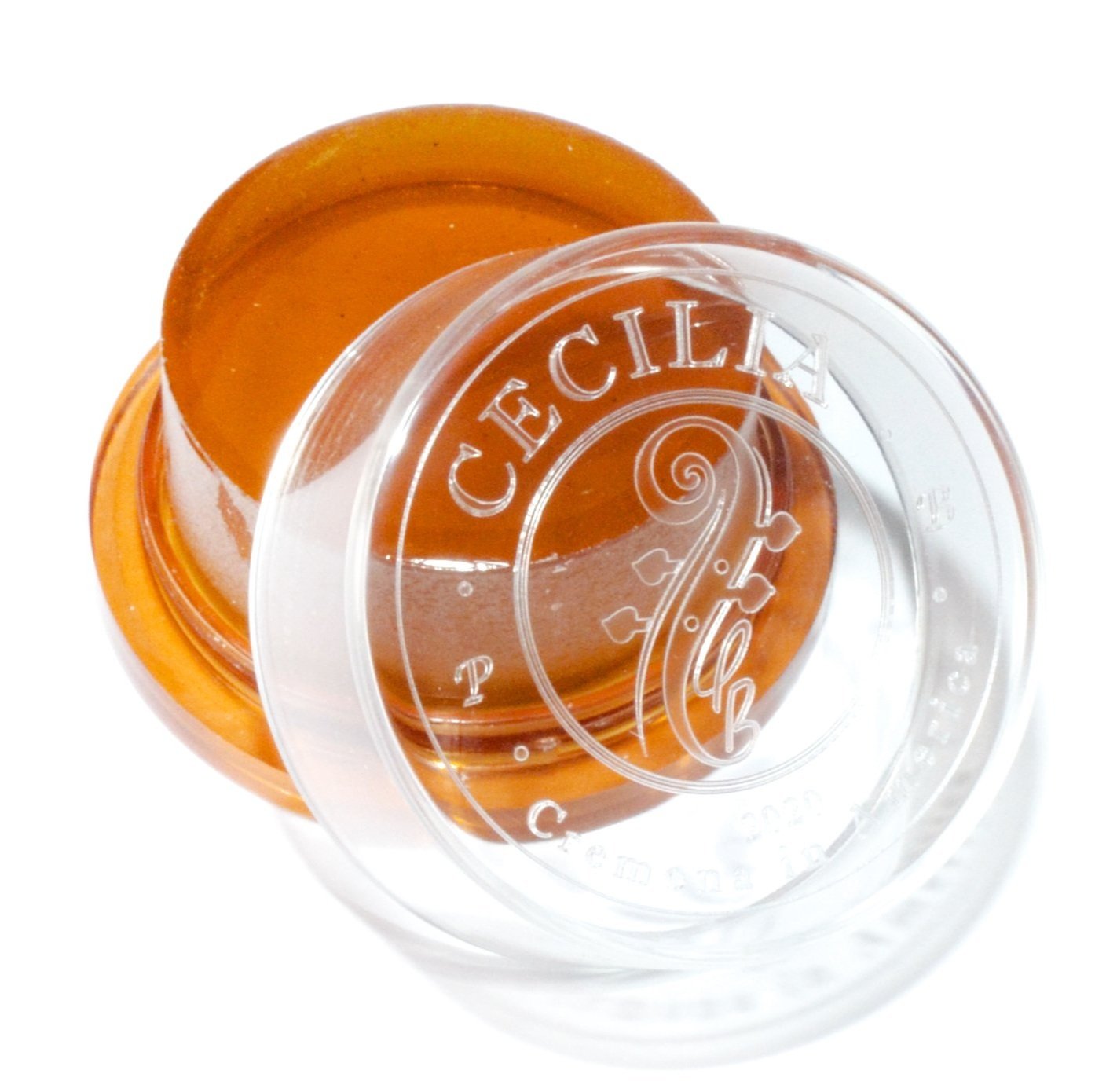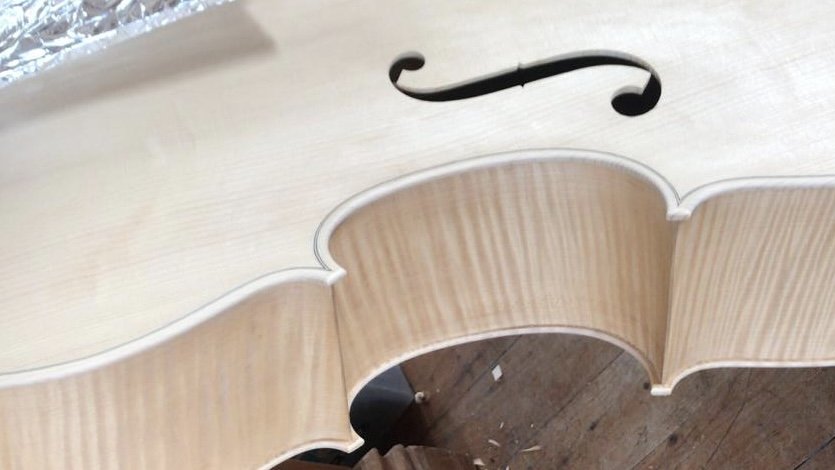
The CECILIA Premium Rosin Collection
CECILIA SANCTUS
A unique and special two part rosin from Cremona in America. Made to celebrate the 10th anniversary of Cremona in America …more
CECILIA SIGNATURE FORMULA
This rosin is the most significant new development for the most demanding musicians…more
CECILIA SOLO
Clarity! CECILIA Solo rosin gives a pure, clean and projecting sound that soloists love…more
CECILIA A PIACERE
A Piacere rosin gets the most out of your instrument and adds that 'extra something'…more
CECILIA DOUBLE BASS SOFTER & FIRMER
Launched in March 2024, two new rosin formulas for double bass…more
CECILIA ROSIN SPREADER
This new essential device is a simple yet effective solution to enhance the quality of your daily playing …more
CECILIA ROSIN Cremona in America
Peter Bahng has been making his rosins in New York since 2009, although his rosin formulas were developed while he was still studying violin at The Cleveland Institute.
Over 200,000 rosins have been made by Peter since then, and to this day, each and every rosin is still hand crafted . The making process has been refined and improved during this time. His rosins have become known and trusted worldwide for their excellent playing properties.
Professional musicians rely on CECILIA rosins to create a great sound and to give artistic freedom. During 2020, Peter Bahng changed the name of the rosins from ANDREA to CECILIA. The CECILIA rosin collection offers the original, unchanged and popular Solo rosin together with the A Piacere and Sanctus models. Orchestra rosin was discontinued.
The latest addition to the professional line-up, Signature Formula was developed to be the new star of the CECILIA rosin collection. As with the other CECILIA rosins, this new rosin has received accolades from professional musicians around the world.
All CECILIA rosins sold in the European will be labelled with a CLP label in accordance with European Legislation. If your CECILIA rosin does not have this label then it will not have been supplied within the European Union . Please check if you have any concerns.
RECYCLING INFORMATION:
ROSIN CASE BASE: Made of 100% Polystyrene (PS) - Please recycle.
ROSIN CASE LID: Made of 100% Poly Methyl Methacrylate (PMMA) - Please recycle.
"True Artist" by Cecilia Rosin Collection
Product Identifier: Rosin; Colophany, CAS No. 8050-09-7
The following information applies to all makes of violin, viola, cello and bass rosins that contain rosin made from tree sap:
Safety Notes H statements
h317: May cause an allergic skin reaction.
Safety Notes P statements
p261: Avoid breathing dust/fume/gas/mist/vapours/spray.
p280: Wear protective gloves/protective clothing/eye protection/face protection.
p302-p350: IF ON SKIN: Wash with plenty of water/…
p333-p313: If skin irritation or rash occurs: Get medical advice/attention.
p362+P364: Take off contaminated clothing / Wash contaminated clothing before reuse.
p501: Dispose of contents/container to an authorised waste collection point

The history of Cecilia Rosin, from inception to the present day.
The idea
The spark that ignited the current line of Cecilia rosins happened in 1998. At that time a young Peter Bahng, creator of Cecilia rosins, was practising his violin in his father's workshop.
Peter's father Andrea was dedicated to researching and testing new types of varnish for string instruments. He used various ingredients, many of which came from different types of sap.
While Peter practised his violin, he liked to experiment with different types of rosin to help him play more easily. He knew that varnish and rosins had ingredients in common, so his youthful curiosity prompted him to continue researching and experimenting further, testing a wide variety of ingredients and formulas.
Making the rosins available
Peter started experimenting with small amounts of different rosins until he came across a compound that not only made his performances easier, it also enhanced his sound. Quickly, Peter, excited, explained about his discovery to his father Andrea and his mother Cecilia, and together they had a talk where they explored the possibilities of commercialising the product.
Shortly after, Peter had to return to the United States to resume his studies at the Cleveland Institute of Music, but during this time, his parents sought the support and partners necessary to launch the original Tartini resin in 2001. A legend had just been born.
What happened next
Some time after the original Tartini rosin was released, it went through a series of unfortunate changes of associates and business conflicts. These resulted in the name change from Tartini to Andrea. Product quality was also affected by these events; during this time, the Andrea rosin was being manufactured by two different companies, with different formulations.
From this point on, the rosin began to lose part of its fan base and popularity with musicians and distributors due to inconsistencies in quality and availability. In 2007, the production of Andrea rosins ceased permanently ... and for some time.
The rebirth
Let's take a quick look at the present: Peter still has accurate memories of the touch and sound of the original formulas he made himself. His mother Cecilia, who was always the point of union for the family, kept the original formulas and processes safe and secure throughout the years.
In 2009, while Peter was working as a professional violinist in New York, he founded the company Cremona in America to bring back, with the help of his mother Cecilia, the Andrea rosin with the original formula, made without compromise for the professional musician.
Peter regained the enthusiasm and curiosity of his youth that had led him to make the original rosin and created, additionally, new formulas that would complete the range of Andrea rosins. Up until 2020, when the name changed from Andrea to Cecilia, Peter had produced more than 200,000 individual Andrea rosins.
From ANDREA to CECILIA and Why
Sadly, Peter's mother Cecilia passed away unexpectedly in 2019. Peter decided to change the name of his rosins to Cecilia in honour of his mother. He continued with his commitment to develop his rosins, recognised worldwide for their high quality, while honouring the memory of his beloved mother. Incidentally, Cecilia is also the patron saint of musicians, so it seemed the right name for an essential item for professional string players.
From 2020 and into the Future
From the beginning of 2020, Peter only produced rosins under the CECILIA brand. The new CECILIA rosin collection offers the original and popular Solo rosin together with the A Piacere and Sanctus models. A new addition to the professional line-up called Signature Formula has been developed as the flagship of the CECILIA rosin collection. As with his other rosins, this new rosin has received acceptance and accolades from professional musicians around the world.
Sanctus, A Piacere, Solo, and Orchestra rosins have all been made under the ANDREA brand name. From spring 2020, Cremona in America began replacing the name ANDREA with CECILIA. Orchestra rosin has been discontinued
There is no change in the rosin formulas whatsoever.















